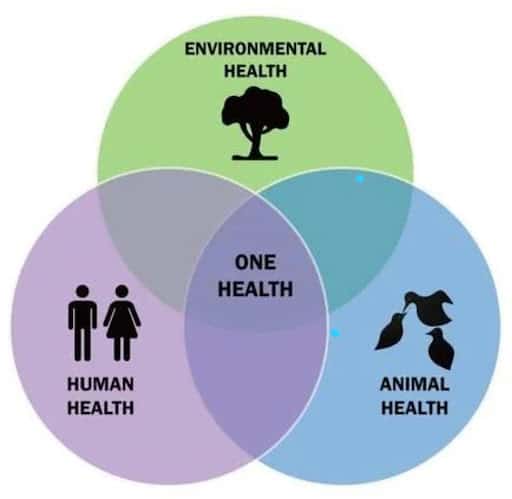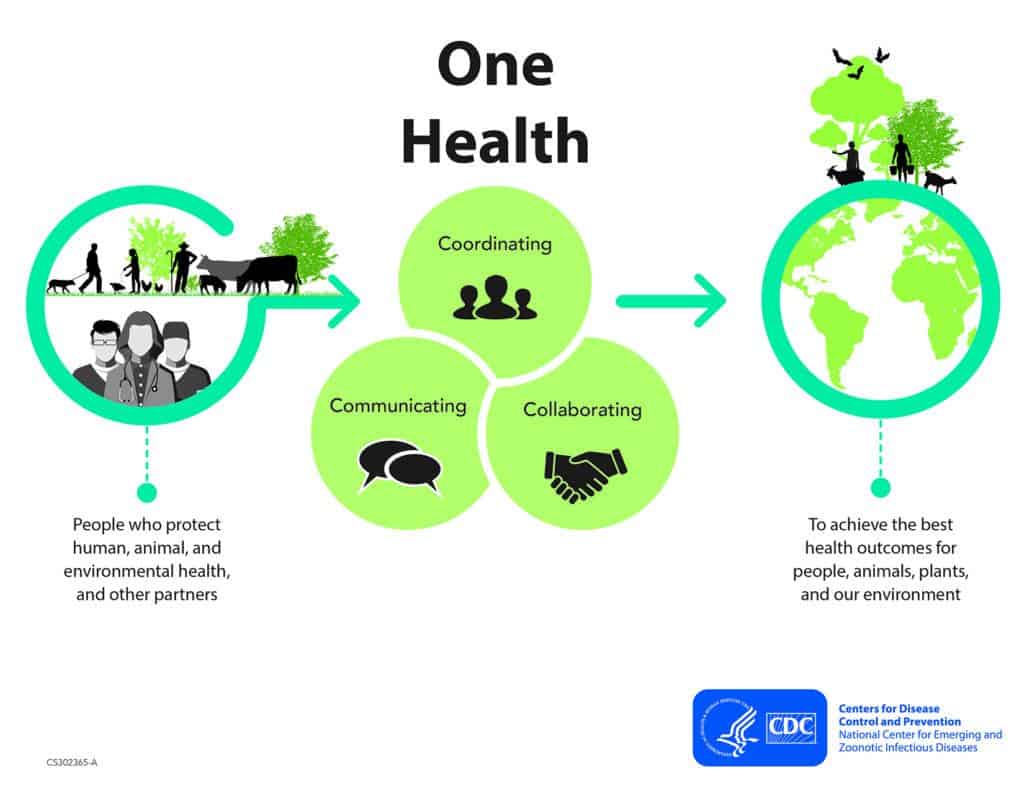The COVID-19 pandemic, a global public health crisis resulting from a virus of potential animal origin has put the spotlight on the idea of One Health. One Health is an approach that is based on the fact that the health of people is closely connected to the health of animals and our shared environment. It brings focus on the interactions between people, animals, plants and the environment.
Health risks have increased with trade globalisation, global warming and changes in human behaviour, providing pathogens multiple opportunities to colonise new territories and mutate. While zoonotic transmission (transmission of pathogens from animals to humans) is a big risk, animal health is also impacted by diseases passed from humans. SARS-CoV-2, tuberculosis, and various influenza viruses, among others, can harm or be fatal to different species of animals.

One Health, a collaborative, multisectoral, and transdisciplinary approach initiated by World Health Organisation (WHO) and partner multilateral agencies — can work at multiple levels. It is important for cities like Bengaluru to look at this, and work on integrated public health interventions to ensure well being of people as well as flora and fauna.
Read more: A wish list for public healthcare in 2022
Why One Health concept is important
Not just for COVID-19, the concept of One Health is relevant for the control of diseases such as rabies, avian flu and tuberculosis. It also factors in environmental health, consistently tracking, reporting and improving pollution and climate change metrics.
Dr Nimisha Agarwal, Campaign Lead, Jhatkaa.org, says, “There are many studies that indicate the impact of air pollution on human health, however, even when data is present, it does not translate into action. Pollution-impacted communities are also more vulnerable to infectious diseases like COVID-19.”

Read more: “A digitised card cannot solve problems of access and affordability in public health”
One Health Initiatives at the national and local levels
In India, a One Health consortium was launched in October 2021, inaugurated by Dr Renu Swarup, Secretary, Department of Biotechnology. The consortium comprises 27 organisations, including AIIMS, Delhi, AIIMS Jodhpur, IVRI, Bareily, GADVASU, Ludhiana, TANUVAS, Chennai, MAFSU, Nagpur, Assam agricultural and veterinary university and many more. It is led by DBT-National Institute of Animal Biotechnology, Hyderabad.
There are also many existing cross-cutting policies and regulatory measures that are expected to be integrated into the One Health model in due course. For example, the National Standing Committee on Zoonoses, the Food Safety and Standard Act, India (FSSAI) that stipulates the limits for contaminants, toxic materials, antibiotic residues, pesticides, heavy metals, veterinary drug residues etc,. and government-initiated control programs for zoonotic and highly communicable diseases such as rabies, brucellosis, hand, foot-and-mouth disease.
In Karnataka, an integrated One Health model is yet to take shape, but a state-level task force with public and clinical health experts, veterinarians, wildlife conservationists, and environmentalists is being set up.
D Randeep, Commissioner, Health, Government of Karnataka says, “Health in the context of Karnataka has been primarily public health. While animal health is a focus, it needs more attention. Public health and animal health are run in silos. An integrated model with an integrated budget is very much needed.”
Randeep, who was formerly Special Commissioner at BBMP feels this is very relevant at the local level. “(Programmes for) vector-borne diseases such as malaria, dengue will definitely benefit from this model. Likewise zoonotic diseases. BBMP should drive this for Bengaluru district as a pilot and this can be replicated across Karnataka. We must invest in research, technology and private public partnerships. GoK would be willing to support BBMP with whatever may be necessary to make the pilot a success.”
Meanwhile a group of scientists and experts have submitted a draft One Health framework document to BBMP and GoK.
The expert team including Dr Farah Ishthiaq from the Tata Institute of Genetics and Society and Dr Uma Ramakrishnan from the National Centre for Biological Sciences (NCBS) have prepared a One Health plan for the city.
Bengaluru’s One health Framework
- Governance & Capacity Building :
To ensure that a system is in place to govern, manage, coordinate and oversee all One Health activities. To assess and strengthen the multi-disciplinary One Health core capacities required to prevent, detect, and respond to zoonotic diseases and mitigate their impact.
- Surveillance, Preparedness & Response (Human Disease Surveillance):
To enhance citywide coordinated surveillance, preparedness and response for prevention, detection and control of zoonotic diseases.
- Environmental and Vector Surveillance:
To identify circulating pathogens by metagenomic sequencing, in order to get a granular map of the pathogen landscape in the city. To set up environmental surveillance of lakes, stagnant water and groundwater, sewage, drains for pathogens (e.g., SARS-CoV-2, panpathogen surveillance, antimicrobial resistance) and build models that link spillover and its spatial and temporal monitoring through such surveillance.
- Disease ecology:
To provide information that can help design effective vector control strategies; Map the disease ecology at the local scale for vector-borne diseases such as dengue, malaria and chikungunya, and zoonoses such as rabies, leptospirosis, scrub typhus and toxoplasmosis (as a start) across Bengaluru city.
- Model and predict:
To conduct consultations and to build partnerships to implement such One Health programmes in the city. To catalyse governmental and industry based One Health solutions, opportunities for growth and development, and guidelines for urbanisation.
- Partnerships, Citizen science and public engagement:
To develop multilevel, multisectoral capacity for communication and advocacy, and to gain commitment and support from all sectors and empower people. To communicate the linkages and balance between biodiversity, climate change and disease to citizens and involve citizen scientists in data collection and monitoring. To develop educational material about the balance between environment, biodiversity and disease for school, undergraduate and master’s curricula.
A collaborative approach: Can Bengaluru show the way?
It is best to begin work at the local level. “BBMP’s earlier models such as dengue surveillance led to an ambitious national scaling up. It is again time for Bengaluru to lead by implementing this well (at the city level) before taking it to the state and national levels,” says Dr Giridhar Babu, Epidemiologist, GoK’s COVID-19 Task Force. Randeep D also agrees and says the government should consider the draft submitted by the experts.
Even if a recently formalised term, the One Health model has been followed in earlier programmes too. National Animal Disease Control Programme (NADCP) is a flagship scheme launched by GOI to control Foot and Mouth Disease and Brucellosis by vaccinating the animals at risk. Likewise, National Centre for Disease Control (NCDC), GoI had launched the National Rabies Control Program (NRCP), a 12-year plan with both animal and human components.
Dr Shrikrishna Isloor, Director, Reference Laboratory (Rabies), OIE World Organization for Animal Health, SE Asia, says: “Brucellosis bacteria is especially more prevalent in organised cattle and sheep groups. Apart from risk to other cattle and sheep, it also puts veterinarians, farmers, handlers, slaughter house agents at risk. NADCP has done well in creating awareness around the diseases and bringing together a community of medical practitioners, veterinarians, risk groups, etc,. to control the disease. We should be able to have a view of the actual impact in the next 2 to 3 year time period.”
The rabies control programme in India has also adopted the principles of One Health; “Our organisation has done many workshops creating awareness about the disease and helping information reach the smallest of towns.” adds Dr Isloor.

In Bengaluru, the local body BBMP has set up a rabies helpline for street dogs This helpline follows a collaborative approach to the benefit of the community at large .
“BBMP is the only custodian for rabies management in Bengaluru. We attempt to control rabies through our Anti Rabies Vaccination program. We also set up a dedicated rabies helpline in 2020. A suspected rabies dog is reported to the helpline and with the help of our team, we help isolate the dog to monitor its symptoms,” says Dr Manjunath Shinde, BBMP.
He adds, “If it’s not rabies, the dog is vaccinated and released. If the symptoms persist and the dog succumbs, we send the brain sample to the laboratory to confirm the disease. On confirmation and with the help of the helpline, we ensure people and animals who have come in contact with the dog get fully vaccinated.”
Dr Shinde says, “Though they have some way to go before eradicating rabies, they will get there and hopefully the One Health model will pick up momentum in our state/country as it will help keep several other zoonotic/reverse zoonotic diseases and their transmission at bay.”
Conclusion
Dr Trilok Chandra, Special Commissioner Health, BBMP says, “The immediate focus is to look at increasing the number of PHCs to one per constituency (198) from 160. Also to build the much needed three-tier healthcare system.”
Trilok Chandra adds, “One Health is an important facet of how we move forward and we look forward to working with various citizen groups, animal and environmental groups to build a holistic health model for the city. Nothing happens without the support of civil society. Right now, with the new mutating virus Omicron, we hope to get support from citizens in strictly following Covid Appropriate Behaviour.”
It is important that the collective welfare of all living beings, humans, animals, trees is considered to protect overall health. One Health is an inclusive model to drive collective good. There is no better place to kick start the pilot than Bengaluru as it has a capable bureaucracy, technology and digital infrastructure, public-private partnerships and importantly a collaborative and invested citizenry.
Here’s to a ‘one healthified’ Bengaluru!
Extending Randeep Sir’s quote a bit “To include citizen participation” in such endeavours.
Citizen participation in this pandemic proves Govt can execute lot of society centric projects with active citizens allowed to participate at grassroot levels.
A very well written article with lot of information and research. Kudos to Harini Raghavan